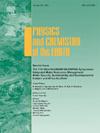Long-term simulation of process and hydrogeochemistry of gas field produced water reinjection into a limestone reservoir
IF 4.1
3区 地球科学
Q2 GEOSCIENCES, MULTIDISCIPLINARY
引用次数: 0
Abstract
Large water volumes have been injected to enhance oil and gas recovery. However, the generated oil or gas-produced water (GPW) may contain undesirable and harmful substances. Reinjection of GPW into suitable subsurface formations is considered an effective disposal method. In this study, a numerical model of vertical-radial two dimensional well flow was developed to explore the long-term process and hydrogeochemistry of GPW reinjection into a limestone formation, which is considered as a homogeneous equal thickness reservoir. The obtained results indicated that there was an increase in the reservoir pressure at the reinjection well from 150 to 251.4 Bar at a reinjection rate of 300 m3/day. The pressure propagation range extended up to approiximately 3300 m during the injection. Calcite volume caused a maximum volume fraction change of −0.91, corresponding to a dissolution rate of 0.083/year, which increased the reservoir porosity to over 0.9. Reservoir pH values were altered within 90 m of the reinjection well as a result of water-rock interaction. Additionally, concentrations of Ca2+, Mg2+, Na+, Cl−, HCO3−, and SO42− in the reservoir were affected within 2000–3000 m from the reinjection well due to injection pressure, water-rock interactions, and diffusion. This study provides insights into assessing the environmental behaviors of GPW in reservoirs, and ensuring safe, and effective long-term GPW reinjection; though accuracy and reliability of the model requires further validation using practical monitoring data in the future.
石灰岩储层气田采出水回注过程及水文地球化学长期模拟
为了提高油气采收率,注入了大量的水。然而,产生的油或气产出水(GPW)可能含有不需要的有害物质。将GPW回注到合适的地下地层被认为是一种有效的处理方法。本文建立了垂直-径向二维井流数值模型,探讨了GPW回注灰岩地层的长期过程和水文地球化学特征,该地层被认为是均匀等厚储层。结果表明,当回注量为300 m3/天时,回注井的储层压力从150 Bar增加到251.4 Bar。在注入过程中,压力传播范围扩大到约3300 m。方解石体积导致的最大体积分数变化为- 0.91,对应的溶解速率为0.083/年,使储层孔隙度增加到0.9以上。由于水岩相互作用,储层pH值在回注井90 m内发生了变化。此外,在距回注井2000-3000 m范围内,由于注入压力、水岩相互作用和扩散,储层中Ca2+、Mg2+、Na+、Cl−、HCO3−和SO42−的浓度受到影响。该研究为评价储层中GPW的环境行为,确保GPW长期安全有效回注提供了依据;尽管该模型的准确性和可靠性需要在未来使用实际监测数据进一步验证。
本文章由计算机程序翻译,如有差异,请以英文原文为准。
求助全文
约1分钟内获得全文
求助全文
来源期刊

Physics and Chemistry of the Earth
地学-地球科学综合
CiteScore
5.40
自引率
2.70%
发文量
176
审稿时长
31.6 weeks
期刊介绍:
Physics and Chemistry of the Earth is an international interdisciplinary journal for the rapid publication of collections of refereed communications in separate thematic issues, either stemming from scientific meetings, or, especially compiled for the occasion. There is no restriction on the length of articles published in the journal. Physics and Chemistry of the Earth incorporates the separate Parts A, B and C which existed until the end of 2001.
Please note: the Editors are unable to consider submissions that are not invited or linked to a thematic issue. Please do not submit unsolicited papers.
The journal covers the following subject areas:
-Solid Earth and Geodesy:
(geology, geochemistry, tectonophysics, seismology, volcanology, palaeomagnetism and rock magnetism, electromagnetism and potential fields, marine and environmental geosciences as well as geodesy).
-Hydrology, Oceans and Atmosphere:
(hydrology and water resources research, engineering and management, oceanography and oceanic chemistry, shelf, sea, lake and river sciences, meteorology and atmospheric sciences incl. chemistry as well as climatology and glaciology).
-Solar-Terrestrial and Planetary Science:
(solar, heliospheric and solar-planetary sciences, geology, geophysics and atmospheric sciences of planets, satellites and small bodies as well as cosmochemistry and exobiology).
 求助内容:
求助内容: 应助结果提醒方式:
应助结果提醒方式:


